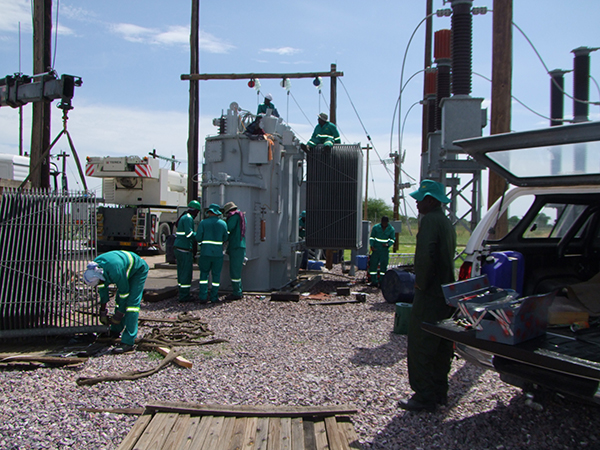Albertina Nakale
Namibia’s low load densities and long distances between major load centres and potential generation points make it challenging for NamPower to expand the power system while ensuring the security of supply, maintaining reliability levels, and keeping the cost of electricity at a reasonable level.
The Namibia Power Corporation is, however, optimistic that Namibia has numerous power supply options that could potentially be developed to meet future electricity requirements.
This information is contained in the national power utility’s 2021 annual report. NamPower’s transmission network has grown to 11 700 kilometres over the years, and is capable of supplying electricity across the vast Namibian landscape.
The company has also increased Namibia’s local generation capacity through refurbishments and upgrades to its existing plants from 345MW to 489.5MW installed capacity, allowing it to provide continuous and reliable electricity in Namibia.
The company is implementing the transmission master plan, which includes plans for the expansion of their transmission capacity, and improving network reliability through the development of key projects to ensure security of supply for Namibia.
This entails the construction of new transmission lines, new substations, and the upgrading of existing transmission infrastructure. The NamPower transmission master plan, for the period 2021 through 2025, describes the transmission network grid expansion plans, and highlights new development requirements for the next five years.
Simson Haulofu, NamPower’s managing director, is proud that the power utility has consistently provided uninterrupted electricity without load-shedding during the past 25 years.
“While our operations this year were clearly impacted by the Covid-19 pandemic, and while low rainfall in the catchment area that supplies the Ruacana Power Station resulted in significantly reduced generation capacity of our main source of least-cost energy supply, NamPower nonetheless stood firm,” he stated.
The company reflected a decrease in generation capacity to 24.1% (from 33.4% in 2020), and an increase in the cost of electricity by 7.1% (from N$4.2 billion in 2020 to N$4.5 billion in 2021).
Haulofu noted that NamPower optimised the balancing of its energy trading supply mix options by sourcing from partners in the Southern African Power Pool (SAPP), and contracting the day-ahead market at cheaper levels. This contributed significantly to the profit of N$1.2 billion recorded for the 2020/21 financial year, the bulk of which was reinvested into capital-intensive generation and transmission projects.
“The marked reduction in energy demand over the last three years is primarily attributed to the persistent global economic downturn and the impact of Covid-19 on all sectors of the economy since its outbreak in January 2020,” reasoned Haulofu.
Sadly, due to relatively low rainfall in southern Angola, the Ruacana power station was not able to operate at optimal capacity during this reporting cycle and generated a mere 968 Gigawatt-hour (GWh) of energy, compared to 1,505 GWh during the 2019/20 financial year.
NamPower continues to rely on regional trading partners to meet the country’s electricity demand.
The catchment area for Ruacana did not receive good rainfall during 2021, resulting in the Ruacana Hydropower station’s flow averaging 93 m3/s (2019/20: 275 m3/s) for the financial year.
This saw a decrease in NamPower’s contribution to total units into the system to 24.1%, compared to 33.4% achieved in the previous year. Equally, this resulted in NamPower importing 67.4% (2019/20: 59%) of the power from neighbouring countries and the Southern African Power Pool (SAPP) market to meet the country’s electricity demand.
The cost of imported electricity was the main contributor to the increased cost of electricity.The Ruacana power station is a run of the river plant, with a seasonal operation of base load during the high river flow season, and mid-merit peaking during the low river flow season.
The poor rainfall recorded in the Kunene River catchment during the 2020/21 rainy season resulted in a very low river flow passing through Ruacana.
As a result of the low Kunene river flow, there was a decline in the electricity generated at the Ruacana power station, down to 968.8 GWh generated in the 2021 financial year, compared to 1504.0GWh during the 2020 financial year.
Haulofu said the station is the most significant contributor of in-country generation, and that there is a negative correlation between the level of NamPower cost of sales and local generation.
This is so since the Ruacana power station produces electricity at comparatively low cents per kilowatt hour due to its legacy status.
Part of the 150MW power-generation investment plan is to de-risk the significant dependency on imports and, at the same time, partially augment the relative importance of the power station.
– anakale@nepc.com.na


